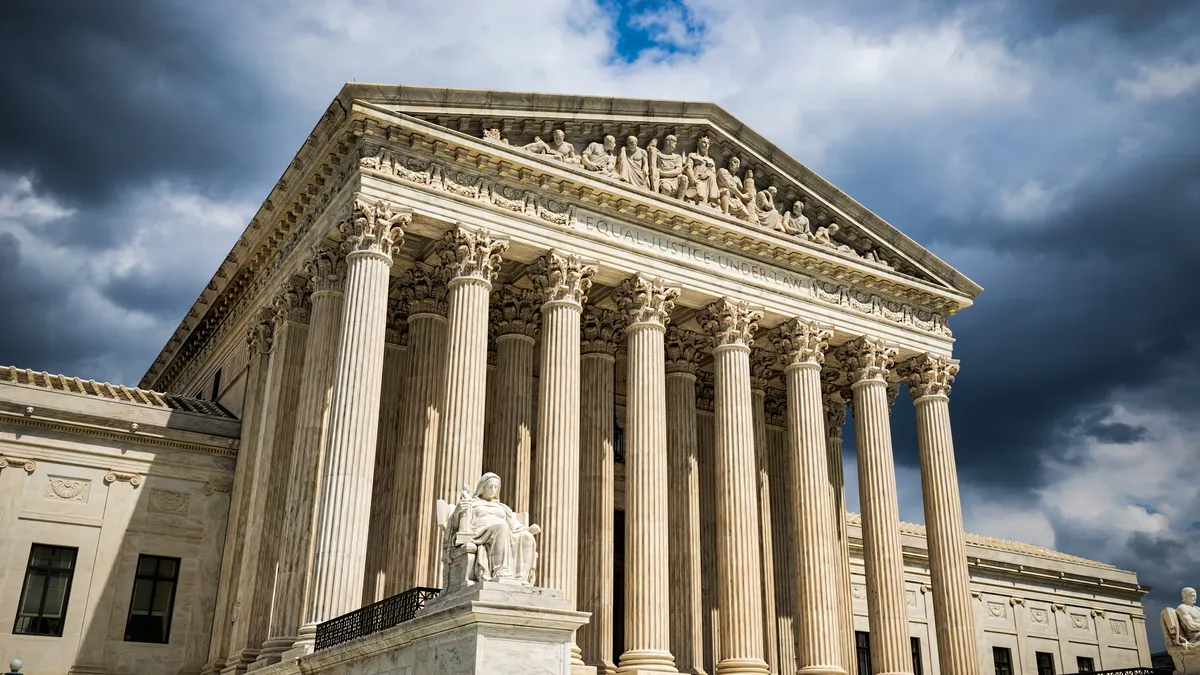Dive Brief:
- The Environmental Protection Agency cannot set fleet-wide greenhouse gas emissions limits for existing power plants under the Clean Air Act’s Section 111(d), the Supreme Court ruled Thursday, dismissing arguments raised by a group of electric utilities, the Biden administration and others.
- Congress did not give the EPA in Section 111(d) of the Clean Air Act the explicit authority to set emissions caps based on the “generation shifting” approach the agency took in the Obama administration’s Clean Power Plan, Chief Justice John Roberts, who wrote the decision, said.
- "Today’s ruling limits the tools available to the [EPA] to sensibly reduce power plant emissions using cost-effective strategies that reflect the realities of an electric power system that is increasingly dynamic and diverse,” Jeff Dennis, Advanced Energy Economy general counsel and managing director, said in a statement. “In light of this Supreme Court decision, it will fall to Congress, state policymakers, and the markets to drive the transition to a clean energy economy.”
Dive Insight:
America’s Power, a group that supports coal-fired generation, praised the court decision.
“We are pleased the Supreme Court issued a decision that restricts the [EPA] from setting carbon dioxide standards for coal-fired power plants based on outside-the-fence measures,” Michelle Bloodworth, America’s Power CEO, said in a statement. “The issue is not whether EPA can regulate carbon dioxide emissions under section 111(d) of the Clean Air Act, but rather what kind of standards the agency is allowed to set.”
The case – West Virginia v. EPA – grew out of the Clean Power Plan, which set broad emissions reduction targets for the power sector, the second leading source of U.S. carbon emissions, but was stayed by the Supreme Court in 2016 before it took effect.
The Trump administration replaced it with the less-stringent Affordable Clean Energy (ACE) rule. However, the U.S. Court of Appeals for the District of Columbia Circuit in January 2021 vacated that rule, saying the EPA took a too-narrow view of its authority to regulate carbon emissions from power plants. Last fall, the Supreme Court agreed to review the D.C. Circuit decision, even though no emissions-reduction regulation was in place.
During oral arguments in February at the Supreme Court, a coalition of states led by West Virginia and an attorney for North American Coal, a coal company, argued the Clean Air Act requires the EPA to regulate generating facilities by setting emissions standards that individual power plants can meet. They asked the Supreme Court to disallow a fleet-wide approach.
Beth Brinkmann, a Covington & Burling attorney representing a group of investor-owned and public utilities, told the court that the Clean Air Act gives the EPA the authority to adopt fleetwide carbon regulations.
“For years, the power companies have used emissions trading, generation shifting, and other measures to reduce emissions while keeping the lights on at reasonable cost,” Brinkmann said.
Utilities in the group include National Grid USA, New York Power Authority, Sacramento Municipal Utility District, Los Angeles Department of Water and Power, Pacific Gas and Electric, Puget Sound Energy and Seattle City Light.
Edison Electric Institute, a trade group for investor-owned utilities, and a water utility trade group in January filed a brief supporting the EPA’s position, in part saying if the agency isn’t allowed to regulate carbon emissions, individual power plants and water facilities could face lawsuits over their emissions.
In its decision, the Supreme Court said the EPA lacks the authority to regulate power plants across fleets instead of on a plant-by-plant basis.
Under a fleet-wide regulatory approach, “EPA can demand much greater reductions in emissions based on a very different kind of policy judgment: that it would be ‘best’ if coal made up a much smaller share of national electricity generation,” the court said. “And on this view of EPA’s authority, it could go further, perhaps forcing coal plants to ‘shift’ away virtually all of their generation — i.e., to cease making power altogether.”
It’s “highly unlikely” Congress gave the EPA the discretion to decide how much coal-based generation there should be over the coming decades, the court said.
Supreme Court Associate Justice Elena Kagan wrote a dissenting opinion that was joined by associate justices Stephen Breyer and Sonia Sotomayor.
The court’s decision “strips” the EPA’s ability to respond to climate change, according to Kagan.
“The majority’s decision rests on one claim alone: that generation shifting is just too new and too big a deal for Congress to have authorized it in Section 111’s general terms,” Kagan said. “But that is wrong. A key reason Congress makes broad delegations like Section 111 is so an agency can respond, appropriately and commensurately, to new and big problems. Congress knows what it doesn’t and can’t know when it drafts a statute; and Congress therefore gives an expert agency the power to address issues — even significant ones — as and when they arise.”
The decision will affect an ongoing rulemaking process at the EPA, which is developing new greenhouse gas emissions standards for existing fossil-fueled power plants and expects to issue a proposed rule in March, according to the Office of Information and Regulatory Affairs’ regulatory agenda.














